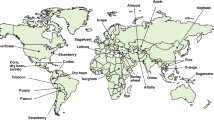Abstract
Understanding the patterns of distribution of plant genetic resources, especially the extent and contextual bases of distributions, may be critical in setting appropriate targets for seed multiplication, packaging, storage space, and other technical operations. We analyzed germplasm distribution patterns over a 12-year period for 10 crop collections conserved by the North Central Regional Plant Introduction Station in Ames, Iowa, to determine if distribution rates over a given time interval help predict future distributions and to document how distribution patterns vary among accessions within collections. We demonstrated that, with an appropriate tracking system and commonly available statistical software, germplasm distribution patterns can be easily analyzed and plotted over time. Data measured over periods of up to 3 years had little predictive value, while a 6-year period gave relatively accurate projections of future distributions. Patterns of distributions within collections varied between those that are approximately normally distributed and those best described by an exponential function, with larger collections tending to be non-normally distributed. Means and standard deviations of standardized, long-term distribution rates, calculated from samples of 200–700 accessions, accurately described the distributional rates of 90–95% of all accessions. The documentation of changes in usage patterns within and among collections as they mature is also discussed. Analysis of average shipment size suggests that germplasm distributions became more focused over time for 8 of the 10 collections analyzed. This may result when users request germplasm based upon knowledge about specific accessions gained through personal experience and by examining evaluation and characterization data.
Similar content being viewed by others
References
Bird E.M. 1994. The USDA germplasm information management and access. Quarterly Bulletin of the International Association of Agricultural Information Specialists 39: 111–115.
Brown A.H.D. and Spillane C. 1999. Implementing core collections-principles, procedures, progress, problems, and promise. In: Johnson R.C. and Hodgkin T. (eds), Core Collections for Today and Tomorrow. International Plant Genetic Resources Institute, Rome, Italy, pp. 1–9.
Cohen S., Duffus J.E., Liu H.Y. and Perry R. 1991. Induction of silverleaf by Bemisia whitefly from California desert whitefly populations. Plant Disease 75: 862.
Correll J.C., Irish B.M., Koike S.T. and Morelock T.E. 2000. Update on downy mildew (Peronospora farinosa f. sp. Unispinaciae) of spinach In: Summaries and Program: International Leafy Vegetable Conference, 25–28 September 2000, Seaside, California., pp. 19-20.
Correll J.C., Morelock T.E., Black M.C., Brandenberger L.P. and Dainello F.J. 1994. Economically important diseases of spinach. Plant Disease 78: 653–660.
Diwan N., Bauchan G.R. and McIntosh M.S. 1994. A core collection for the United States annual Medicago germplasm collection. Crop Science 34: 279–285.
FAO (Food and Agriculture Organization of the United Nations) 1998. The State of theWorld's Plant Genetic Resources for Food and Agriculture. Food and Agriculture Organization of the United Nations, Rome, Italy.
Frankel O.H. 1984. Genetic perspectives of germplasm conservation. In: Arber W.K., Llimensee K., Peacock W.J. and Starlinger P. (eds), Genetic Manipulation: Impact on Man and Society. Cambridge University Press, Cambridge, UK, pp. 161–170.
Gibbons J.D. 1976. Nonparametric Methods for Quantitative Analysis. American Sciences Press, Columbus, Ohio.
Goodman M.M. 1990. Genetic and germ plasm stocks worth conserving. Journal of Heredity 81: 11–16.
McFerson J.R., Lamboy W.F. and Kresovich S. 1996. Assessing user perceptions of genetic resource collections in crucifer crops. Crop Science 36: 831–838.
Morales E.A.V., Valois A.C.C. and Costa I.R.S. 1995. Core collections for gene banks with limited resources. In: Hodgkin T., Brown A.H.D., van Hintum T.J.L. and Morales E.A.V. (eds), Core Collections of Plant Genetic Resources. John Wiley, Chi-chester, UK, pp. 241–249.
MSTAT Development Team 1994. MSTAT-C Version 2.1: A Microcomputer Program for the Design, Management and Analysis of Agronomic Research Experiments. Michigan State University, East Lansing.
Nanda Kumar P.B.A., Dushenikov V., Motto H. and Raskin I. 1995. Phytoextraction: The use of plants to remove heavy metals from soils. Environmental Science and Technology 29: 1232–1238.
Sackville-Hamilton N.R. and Chorlton K.H. 1997. Regeneration of Accessions in Seed Collections: A Decision Guide. Handbook for Genebanks No. 5. International Plant Genetic Resources Institute, Rome, Italy.
Sokal R.R. and Rohlf F.J. 1995. Biometry: The principles and practices of statistics in biological research. 3rd edn. Freeman, New York.
Spagnoletti Zeuli P.L. and Qualset C.O. 1995. The durum wheat core collection and the plant breeder. In: Hodgkin T., Brown A.H.D., van Hintum T.J.L. and Morales E.A.V. (eds), Core Collections of Plant Genetic Resources. John Wiley, Chichester, UK, pp. 213–228.
SPSS 1997. Table Curve™ 2D User's Manual. SPSS, Inc., Chicago, Illinois.
SPSS 2000. Sigma Plot® ?2000 User's Guide. SPSS, Inc., Chicago, Illinois.
Widrlechner M.P. 1995. A new look at prairie plant germplasm. In: Hartnett D.C. (ed.), Proceedings of the Fourteenth North Ameri-can Prairie Conference. Prairie Biodiversity, Kansas State Unispinaciae) versity, Manhattan., pp. 207–210.
Widrlechner M.P. 1997. Managerial tools for seed regeneration. Plant Varieties and Seeds 10: 185–193.
Wilson R.L. and Mihm J.A. 1997. Maintenance of, and requests for, maize germplasm having resistance to insect pests. In: Insect Resistant Maize: Recent Advances and Utilization. Proceedings of an International Symposium held at the International Maize and Wheat Improvement Center, 27 November-3 December 1994, CIMMYT, Mexico City, D.F., pp. 230–233.
Wilson R.L., Wiseman B.R. and Reed G.L. 1991. Evaluation of J. C. Eldredge popcorn collection for resistance to corn earworm, fall armyworm (Lepidoptera: Noctuidae), and European corn borer (Lepidoptera: Pyralidae). Journal of Economic Entomology 86: 952–956.
Zitter T.A., Hopkins D.L. and Thomas C.E. (eds) 1996. Compen-dium of Cucurbit Diseases. APS Press, Saint Paul, Minnesota.
Author information
Authors and Affiliations
Corresponding author
Rights and permissions
About this article
Cite this article
Widrlechner, M.P., Burke, L.A. Analysis of germplasm distribution patterns for collections held at the North Central Regional Plant Introduction Station, Ames, Iowa, USA. Genetic Resources and Crop Evolution 50, 329–337 (2003). https://doi.org/10.1023/A:1023575227094
Issue Date:
DOI: https://doi.org/10.1023/A:1023575227094




